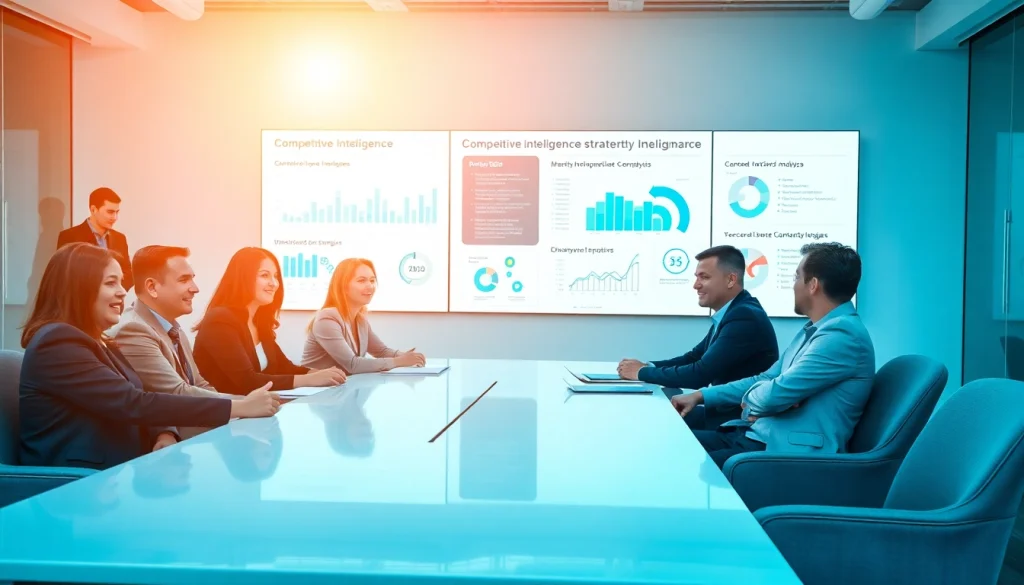
Understanding Competitive Intelligence
Definition of Competitive Intelligence
Competitive intelligence is a strategic process that involves the systematic gathering, analysis, and dissemination of information about competitors, consumers, and the market environment. The essence of competitive intelligence lies in transforming data into actionable insights that can inform business strategy and boost organizational performance. It encompasses a variety of practices, including monitoring market trends, analyzing competitor actions, and understanding customer preferences. By engaging in competitive intelligence, organizations can enhance their decision-making processes and maintain a competitive edge in their respective industries.
The Importance of Competitive Intelligence
In today’s fast-paced business landscape, organizations must recognize the value of competitive intelligence. It assists businesses in anticipating market shifts, identifying new opportunities, and mitigating potential threats. Competitive intelligence helps organizations to:
- Understand the competitive landscape: By keeping insights on rivals, companies can devise more effective strategies that capitalize on competitor weaknesses.
- Enhance decision-making: With data-driven insights, businesses can make informed decisions that align with market conditions and customer needs.
- Improve operational efficiency: Identifying best practices from competitors can lead to enhanced processes and greater productivity.
- Strengthen customer relationships: Understanding consumer behavior helps in tailoring offerings that resonate with target audiences.
Key Components of Competitive Intelligence
There are several key components integral to a robust competitive intelligence framework:
- Market Intelligence: This involves the collection of data regarding market conditions, trends, and dynamics.
- Competitor Intelligence: This includes information about competitors’ strategies, strengths, weaknesses, and market positions.
- Customer Intelligence: Understanding customer needs and preferences helps businesses create products and services that meet market demand.
- Technological Intelligence: Keeping an eye on technological advancements can lead companies to adopt innovations that enhance their offerings.
How to Gather Competitive Intelligence
Methods of Data Collection
Organizations can utilize a diverse range of methods to collect competitive intelligence. Here are some effective strategies:
- Surveys and questionnaires: Direct feedback from customers and stakeholders can reveal valuable insights.
- Social media monitoring: Observing competitors’ social media activities provides clues about their marketing strategies and customer interactions.
- Public filings and reports: Analyzing industry reports, earnings calls, and regulatory filings can yield intelligence on competitor performance and strategies.
- Networking and industry events: Attending trade shows, webinars, and networking events can facilitate the gathering of insights from industry experts.
Analyzing Competitor Strategies
Once data has been gathered, it is essential to analyze competitor strategies to derive actionable insights. Companies can employ various analytical frameworks, such as:
- SWOT Analysis: Assessing strengths, weaknesses, opportunities, and threats provides a comprehensive view of where competitors stand.
- Porter’s Five Forces: This model helps in understanding the competitive forces within an industry and the relative position of the competitors.
- Benchmarking: Comparing key performance indicators with industry standards can highlight areas for improvement.
Tools for Gathering Intelligence
Several tools and technologies can aid in the collection and analysis of competitive intelligence. These tools range from specialized software to general-purpose applications:
- Web scraping tools: These enable businesses to automate the collection of data from competitors’ websites.
- Google Alerts: Setting up alerts for competitor mentions can provide real-time updates on their activities.
- Social listening tools: Applications such as Hootsuite and Brandwatch help monitor brand mentions and customer sentiments.
- Business intelligence platforms: Tools like Tableau, Power BI, and others offer powerful data visualization and analytical capabilities.
Analyzing Competitive Intelligence
Data Analysis Techniques
Data analysis forms the backbone of effective competitive intelligence. Here are several techniques for thorough data analysis:
- Descriptive Analytics: This technique helps to summarize past data to identify trends over time.
- Predictive Analytics: Utilizing statistical algorithms and machine learning techniques can help predict future outcomes based on historical data.
- Prescriptive Analytics: This involves providing recommendations on actions to take based on the analytical insights derived.
Identifying Market Trends
Recognizing market trends is vital for companies aiming to stay ahead. Here are some steps to effectively identify trends:
- Analyze historical data: Look for patterns in past performance to predict future trends.
- Monitor industry publications: Regularly review industry journals and newsletters to catch emerging trends early.
- Engage with thought leaders: Following influencers and experts can provide insights into anticipated changes in the market landscape.
Creating Actionable Insights
The ultimate goal of competitive intelligence is to create insights that drive action. To ensure insights are actionable, consider the following:
- Prioritize insights: Focus on high-impact areas that align with business objectives.
- Communicate findings effectively: Use compelling visuals and clear narratives to convey insights to stakeholders.
- Incorporate feedback: Allow for discussions and input from various teams to refine insights further.
Implementing Competitive Intelligence in Business
Setting Objectives for Intelligence Use
To successfully implement competitive intelligence, organizations must establish clear objectives. Objectives should be SMART—specific, measurable, achievable, relevant, and time-bound. Here are several goals businesses could focus on:
- Enhancing product offerings: Use customer feedback to inform product development.
- Improving marketing strategies: Adapt marketing tactics based on insights from competitor analysis.
- Identifying new opportunities: Seek out gaps in the market highlighted by trend analysis.
Integrating Intelligence into Strategy Development
Competitive intelligence should become a central component of strategic planning processes. To integrate it effectively, organizations can:
- Establish cross-functional teams: Encourage collaboration between departments to utilize intelligence effectively.
- Regularly review strategies: Use competitive intelligence findings to adjust both short-term and long-term strategies as needed.
- Embed in decision-making: Leverage insights at every level of decision-making, ensuring that data informs strategy.
Measuring the Impact of Competitive Intelligence
Measuring the success of competitive intelligence initiatives is vital for demonstrating value. Organizations should establish key performance indicators (KPIs) to track performance. Potential KPIs include:
- Increase in market share: A gradual increase could signify effective competitive strategies.
- Improvement in customer satisfaction ratings: Enhanced offerings informed by competitive insights may lead to happier customers.
- Success in new product launches: Analyzing the impact of intelligence on new product performance can provide valuable feedback.
The Future of Competitive Intelligence
Emerging Trends in Competitive Intelligence
As industries evolve, so do the methods and importance of competitive intelligence. Key trends to watch include:
- Artificial Intelligence and Machine Learning: These technologies will enable the automated gathering and analysis of massive amounts of data, leading to faster and more accurate insights.
- Big Data Analytics: The ability to analyze large datasets will provide deeper insights into market dynamics and consumer behavior.
- Increased Emphasis on Cybersecurity: With the rise of digital data, ensuring the security of competitive intelligence processes will become paramount.
Challenges and Considerations
While competitive intelligence offers immense benefits, challenges remain. Organizations should consider:
- Data Privacy Regulations: Compliance with regulations such as GDPR can complicate data gathering.
- Information Overload: Distinguishing valuable insights from irrelevant data can be difficult without a strong framework in place.
- Internal Resistance: Encouraging widespread buy-in from staff for competitive intelligence practices is often necessary for success.
Preparing for Future Competitive Landscapes
To adapt to tomorrow’s competitive landscapes, organizations should foster a culture of continuous learning and flexibility. This could involve:
- Ongoing training: Regular training sessions ensure that teams remain proficient in competitive intelligence practices.
- Adaptability in strategy: Being open to pivoting business strategies based on fresh insights can lead to sustainable growth.
- Encouraging Innovation: A focus on innovation can help organizations stay ahead in a rapidly changing environment.






